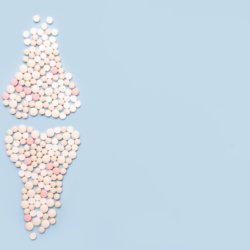Vaginal mycosis, also known as “candidiasis“, corresponds to an imbalance in the vaginal microbiota, most often involving Candida albicans. Vaginal candidiasis is common, affecting 75% of sexually active women. However, genital candidiasis is rare in men and is due to sexual contamination, with lesions that usually regress spontaneously.
What is vaginal mycosis?
Vaginal mycosis is an opportunistic infection, and it is essential to look for the factors contributing to it and eliminate them to avoid recurrence as much as possible. There are many antifungal agents available to treat genital mycosis, but recurrences are common.
In recent years, mycoses have become a frequently encountered condition. The increase in the number of immunocompromised patients and the appearance of multiple strains resistant to antifungal agents are the main causes. However, these mycoses can also be the result of the administration of drugs that encourage them. Several classes of medication have the side-effect of causing fungal infections. The incidence of opportunistic fungal infections has also changed. Poorly disinfected jacuzzis and swimming pools can also encourage the transmission of these vaginal infections.
What are the symptoms of vaginal mycosis?
Pruritus, burning, vaginal or vulvar irritation that can worsen with intercourse and dyspareunia, as well as a thick, white, curd-like vaginal discharge adhering to the vaginal walls, are quite common symptoms of a vaginal candidiasis infection. Symptoms are generally aggravated during the week preceding menstruation. Erythema, oedema and even excoriations are common.
Some naturopathic advice to limit the discomfort caused by vaginal mycosis
- Choose cotton panties
- Avoid wearing clothes that are too tight
- Avoid using acid soaps
- Treat your partner
- Avoid acid-forming foods to avoid acidifying the body and causing fungus to proliferate
- Hygiene: Wash 2 times a day with an intimate cleansing solution or soap that respects the balance of the flora during menstruation or when you have a yeast infection
- Pat dry with a clean cloth after cleansing
- A quick reminder, ladies: remember to wipe from front to back, and not the other way round, to avoid any risk of recurrence
- Consider oral or topical probiotics
The role of diet in vaginal mycosis
Diet plays a vital role in the prevention and treatment of vaginal mycosis. Studies show that diet can influence the body’s microbial balance, particularly in terms of vaginal flora. An unbalanced diet can lead to an overgrowth of Candida albicans, the fungus most often responsible for vaginal mycosis. Simple sugars, for example, are known to encourage the proliferation of this fungus.
On the other hand, a diet rich in fibre, antioxidants and essential nutrients can help strengthen the immune system and maintain a balanced pH in the vaginal area, which is unfavourable to the overgrowth of Candida. Consumption of probiotics, found in fermented foods or supplements, can also support vaginal health by strengthening beneficial bacteria and inhibiting fungal growth.
Specific dietary advice to combat vaginal fungal infections
Here are some dietary recommendations for the prevention and treatment of vaginal mycosis:
- Reduce your intake of simple sugars: Reduce your consumption of refined sugars and foods with a high glycaemic index, as they can fuel the growth of Candida.
- Favour fibre-rich foods: The fibre found in vegetables, fruit and wholegrain cereals aids digestion and helps regulate blood sugar levels.
- Include sources of probiotics: Incorporate foods such as plain yoghurt, kefir, sauerkraut and other fermented foods into your diet to help restore the balance of intestinal and vaginal flora.
- Eat antifungal foods: Some foods have natural antifungal properties. For example, garlic, coconut and coconut oil can help reduce the proliferation of Candida.
- Opt for essential fatty acids: Omega-3 fatty acids, found in oily fish such as salmon, flaxseed and walnuts, are beneficial for their anti-inflammatory action.
- Select sources of vitamins and minerals: Ensure adequate consumption of zinc, vitamin C and other nutrients that support the immune system.
- Drink enough water: Hydration is essential for eliminating toxins and maintaining optimal functioning of all the body’s systems.
What natural treatments can I use for vaginal mycosis?
A systematic review evaluated the effectiveness of plant extracts against the proliferation of Candida albicans, the most common fungal pathogen in humans. Extracts of several plants, including Lawsonia inermis (henna), Pelargonium graveolens (geranium), Camellia sinensis (green tea), Mentha piperita (peppermint) and Citrus latifolia (lime), demonstrated significant antifungal activity, thanks in particular to their phenolic components such as gallic acid, thymol and flavonoids, notably catechin.
Aromatherapy:
In the context of vulvovaginal candidiasis, a study revealed the effectiveness of white thyme and oregano essential oils, diffused in the form of steam, in inhibiting the formation of biofilms and destroying mature biofilms of resistant Candida strains. These results pave the way for the potential use of these essential oils as a preventive or therapeutic treatment for vaginal infections linked to biofilms, offering an interesting alternative to traditional antifungal treatments.
Tea tree essential oil:
Tea tree essential oil, known for its broad-spectrum antibacterial properties, is particularly effective in the treatment of genital infections, including those caused by Candida albicans. Its antifungal properties can be attributed to the presence of monoterpene alcohols and carbides in its composition. These compounds are active even against strains of candidiasis resistant to common antifungal drugs, such as fluconazole. This makes tea tree essential oil a valuable option for treating fungal infections that are difficult to manage with conventional treatments.
Rose geranium essential oil:
Rose geranium essential oil is known for its antibacterial and antifungal properties, making it particularly suitable for treating vaginal mycoses. Its active ingredients offer an effective approach against various pathogens, including the fungal strains responsible for vaginal infections. Its ability to fight fungal infections, in addition to its antibacterial properties, makes it a relevant choice for a natural, complementary approach to the treatment of vaginal mycoses.
Formula:
To develop an aromatic protocol for treating vaginal mycosis, you may consider using essential oils combined with an oily macerate. A mixture of essential oils such as lavender aspic, geranium, Roman chamomile and fragonia, diluted in an oily macerate of calendula, can be effective. These oils have anti-fungal, anti-pruritic, anti-inflammatory and cooling properties. Apply this mixture to the affected area several times a day for 10 to 15 days. It is important to carry out a skin sensitivity test before application and to consult a health professional if necessary.
Homeopathy:
To relieve symptoms:
- For itching and burning oedema : Apis mellifica 15 CH
Dosage: 5 granules every 30 minutes.
- For thick, white discharge: Helonias dioica 7 CH
Recommended dosage: 5 granules 2 times a day.
- To reduce sensitivity to Candida albicans: Candida albicans 15 CH
Dose: 5 granules per day.
To prevent recurrence of vaginal mycosis:
- As a basic treatment: Candida Albicans 15 CH
Dosage: 5 granules per day for 1 month, then 1 full dose per week for 2 weeks.
Depending on the condition and circumstances, add:
- If repeated antibiotic treatment and recurrent mycoses : Medorrhinum 15 CH
Dosage: 1 dose per week for 3 months.
- If repeated urinary and gynaecological infections, cold women discouraged by the failure of treatment: Psorinum 15 CH
Dosage: 1 dose per week for 3 months.
- If there is a tendency to be too hygienic, a taste for sweets, abundant but not very irritating discharge: Pulsatilla 15 CH
Dosage: 1 dose per week for 3 months.
- If heavy discharge alternates with vaginal dryness: Sepia 15 CH
Dose: 1 dose per week for 3 months.
Are probiotics effective in cases of vaginal mycosis?
The effectiveness of probiotics, particularly lactobacilli, in the treatment of vulvovaginal candidiasis (VVC) is supported by research indicating that these beneficial bacteria can help to balance the vaginal microflora. The natural presence of lactobacilli in healthy vaginal flora plays a key role in preventing pathogen overgrowth, notably by producing inhibitory substances such as organic acids and hydrogen peroxide. Probiotics could therefore offer a method of preventing and treating VVC, potentially reducing recurrent infections and the costs associated with conventional therapies. This is a promising approach to managing VVC and deserves to be explored further.
What is the difference between vaginal mycosis and VVC?
Vaginal mycosis and vulvovaginal candidiasis (VVC) are terms often used interchangeably to describe a vaginal infection caused primarily by the fungus Candida albicans. However, vaginal mycosis refers broadly to any fungal infection in the vaginal area, whereas VVC focuses specifically on infections caused by Candida species. In clinical practice, these terms are commonly used to describe the same type of infection.
What precautions should be taken?
The use of naturopathic treatments for vaginal mycosis must be accompanied by certain precautions. It is essential to check the origin and quality of herbs and supplements to avoid any risks associated with poor quality or contaminated products. It is imperative to consult a health professional before using them, because of possible interactions with other drug treatments and potential contraindications.
When is it necessary to consult a doctor in the event of vaginal mycosis?
Medical advice is essential in a number of situations. Medical advice should be sought as soon as symptoms first appear, in order to obtain an accurate diagnosis. If symptoms persist or intensify despite the use of natural remedies, you should also seek medical advice. Similarly, in the event of frequent recurrence of symptoms, pregnancy, the presence of other illnesses, or adverse reactions to natural treatments, medical advice is crucial. Vaginal health is a delicate issue, and naturopathic approaches should be used with discernment and in conjunction with traditional medicine, not as a substitute for it.
Read more:
- Mycoses. 2004 Apr;47(3-4):87-92. doi: 10.1046/j.1439-0507.2003.00951.x.
Herbal medicines for treatment of fungal infections: a systematic review of controlled clinical trials - Mini Rev Med Chem. 2021;21(1):90-117. doi: 10.2174/1389557520666200628032116.
Herbal Extracts with Antifungal Activity against Candida albicans: A Systematic Review - Journal of Medical Mycology. Volume 33, Issue 1, March 2023, 101329. Simulated vaginal fluid: Candida resistant strains’ biofilm characterization and vapor phase of essential oil effect
- Front Cell Infect Microbiol. 2023 Feb 3:13:1123026. doi: 10.3389/fcimb.2023.1123026. eCollection 2023.
Vulvovaginal candidiasis and vaginal microflora interaction: Microflora changes and probiotic therapy





